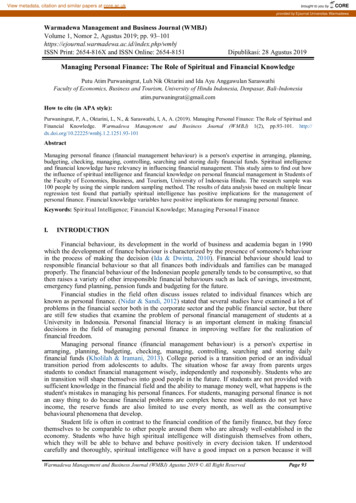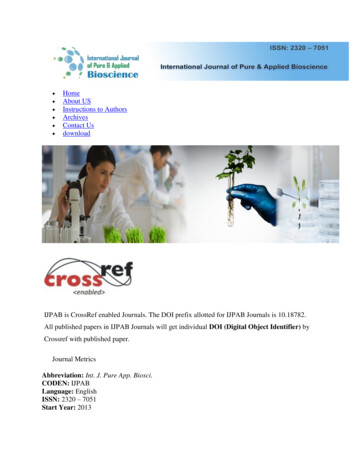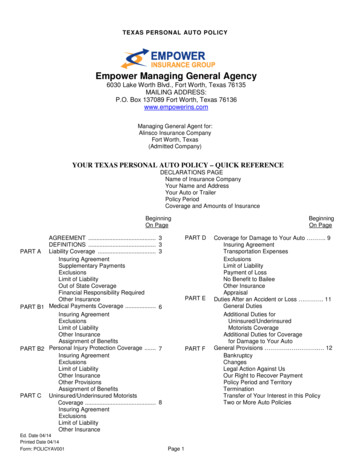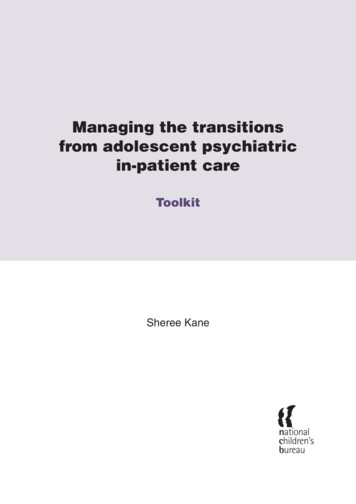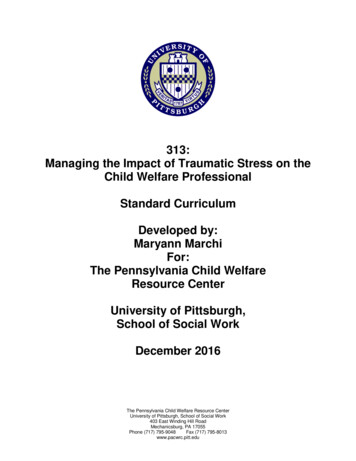
Transcription
313:Managing the Impact of Traumatic Stress on theChild Welfare ProfessionalStandard CurriculumDeveloped by:Maryann MarchiFor:The Pennsylvania Child WelfareResource CenterUniversity of Pittsburgh,School of Social WorkDecember 2016The Pennsylvania Child Welfare Resource CenterUniversity of Pittsburgh, School of Social Work403 East Winding Hill RoadMechanicsburg, PA 17055Phone (717) 795-9048Fax (717) 795-8013www.pacwrc.pitt.edu
Copyright 2016, The University of PittsburghThis material is copyrighted by The University of Pittsburgh. It may be used freely fortraining and other educational purposes by public child welfare agencies and other notfor-profit child welfare agencies that properly attribute all material use to The Universityof Pittsburgh. No sale, use for training for fees or any other commercial use of thismaterial in whole or in part is permitted without the express written permission of ThePennsylvania Child Welfare Resource Center of the School of Social Work at TheUniversity of Pittsburgh. Please contact the Resource Center at (717) 795-9048 forfurther information or permissions.The Pennsylvania Child Welfare Resource Center313: Managing the Impact of Traumatic Stress on the Child Welfare Professional
AcknowledgementsThe Pennsylvania Child Welfare Resource Center would like to thank the followingpeople for their assistance in the creation/revision of 313: Managing the Impact ofTraumatic Stress on the Child Welfare Professional.NameBrenda BevacquaBernadette Bianchi:Darlene BlackEllen DiDomenicoGene CaprioDeb CioccoVictor CompherKim JamesJoanne DixonCarrie Ann FrolioGordon HodasDenise HoffmanBarbara HugginsKatie Jones-PomeroyDeb LesikRebecca MaguireKaren MallahChuck MazzittiMelanie MillerMaricar NuesaShadell QuinoinesBrian SettaChristy StanekMarsha SturdivantMarcella SzumanskiJoddie WalkerElizabeth WinterJoanne WitkowskiJen ZajacAgencyElk County Children and Youth ServicesPennsylvania Council of Children, Youth, and FamiliesThe Department of Public WelfareOffice of Mental Health and Substance Abuse ServicesThe Pennsylvania Child Welfare Resource CenterPennsylvania PTSD ProjectIndependent TrainerYork County Children and Youth ServicesPace SchoolYork County Children and Youth ServicesOffice of Mental Health and Substance Abuse ServicesThe Pennsylvania Child Welfare Resource CenterThe Pennsylvania Child Welfare Resource CenterThe Pennsylvania Child Welfare Resource CenterCrawford County Children and Youth ServicesClarion County Children and Youth ServicesUniversity of Pittsburgh Medical CenterMazzitti & Sullivan EAP ServicesThe Pennsylvania Child Welfare Resource CenterThe Pennsylvania Child Welfare Resource CenterChester County Children and Youth ServicesCrawford County Children and Youth ServicesAdministrative Office of Pennsylvania CourtsAllegheny County Department of Human ServicesPennsylvania Commission on Crime and DelinquencyAdams County Children’s Advocacy CenterThe University of Pittsburgh; Child Welfare Education andResearch ProgramsAllegheny County Children and Youth ServicesThe Pennsylvania Child Welfare Resource CenterThe Pennsylvania Child Welfare Resource Center313: Managing the Impact of Traumatic Stress on the Child Welfare Professional
313: Managing the Impact of Traumatic Stress on the ChildWelfare ProfessionalAgenda for the 1-Day Workshop on313: Managing the Impact of Traumatic Stress in Child WelfareDay OneEstimated TimeContentPage40 minutesSection I:Welcome and Introductions11 hour, 20 minutesSection II:What is Traumatic Stress630 minutesSection III:The Symptoms of Traumatic Stress121 hour, 15 minutesSection IV:The Impact of Traumatic Stress152 hoursSection V:Strategies for Managing TraumaticStress and Promoting Resiliency2415 minutesThe Pennsylvania Child Welfare Resource CenterSection VI:Summary and Evaluations32313: Managing the Impact of Traumatic Stress on the Child Welfare Professional
313: Managing the Impact of Traumatic Stress on the ChildWelfare ProfessionalSection I: Welcome and IntroductionsEstimated Length of Time:40 minutesLearning/Performance Objectives: Identify the workshop rationale, learning objectives and agenda Identify WIIFMMethod of Presentation:Lecture, small and large group discussion, large group activityMaterials Needed: Flip Chart Pads Flip Chart Stands Laptop LCD Projector/Screen Markers Masking Tape/Poster Putty Name Tents Memo sticky pads Trainer-Prepared Flip Chart: What’s In It For Me? Trainer-Prepared Flip Chart: Parking Lot Music CD (trainer choice) Poster #1: Trainer Ghost Poster #2: Turning Knowledge into Power to Control Stress: Biodot Pre-work: An Overview of Terms (online)o Personal Goal for the Workshop (participants are to access this pagefrom the online pre-work, complete it and bring it to the class.) Trainer Resource #1: Stress and Child Welfare Work (article) Handout #1: Managing the Impact of Traumatic Stress on the Child WelfareProfessional (PowerPoint Presentation) Handout #2: Learning Objectives/Agenda Handout #3: Idea Catcher/Action Plan Handout #4: Pennsylvania’s Child Welfare Practice Model PowerPoint Presentation:o Slide #1: 313: Managing the Impact of Traumatic Stress on the ChildWelfare Professionalo Slide #2: Learning Objectiveso Slide #3: Agendao Slide #4: Quality Service Review Indicator 1a: Safety: Exposure toThreats of HarmThe Pennsylvania Child Welfare Resource Center313: Managing the Impact of Traumatic Stress on the Child Welfare ProfessionalPage 1 of 39
313: Managing the Impact of Traumatic Stress on the ChildWelfare ProfessionalSection I: Welcome and IntroductionsTrainer note:Required reading for the trainer is Trainer Resource #1 (Stress and Child WelfareWork). This is an article by Elizabeth A. Winter.In addition, trainers need to complete Pre-work (An Overview of Terms) to becomefamiliar with the content that the participants have covered. This is the online pre-workparticipants are to complete prior to the classroom workshop. Trainers who have notyet created a username and password for online training, should contact the ChildWelfare Resource Center to obtain and complete the Pre-work prior to coming to theworkshop.Trainer note:The purpose of room preparation is to set a tone of safety, fun, and an environment ofsanctuary. Post Poster #1 (Trainer Ghost) and Poster #2 (Turning Knowledge intoPower to Control Stress: Biodot ) in a visible location in the room. Arrange tables inconference style seating. As participants enter the room, play a relaxing music CD oftrainer’s choice. Also, over breaks and during individual activities, play the music CD.Place one memo sticky pad on each table.Place on tables for each participant, Handout #1 (Managing the Impact of TraumaticStress on the Child Welfare Professional) (PowerPoint Presentation) and one pieceof masking tape or poster putty.Step 1: Introductions and WIIFM: Individual and large group activity.(25 minutes)Before participants arrive, display PowerPoint Slide #1 (313: Managing the Impact ofTraumatic Stress on the Child Welfare Professional), which is the introductory slidefor the training.Whenever possible, start the training session promptly at 9:00 AM.As participants arrive, welcome them and ask them to complete their name tentsfollowing the format below: Name (Center)County (Top-Right Corner)Position (Top-Left Corner)Number of Years with the Agency (Bottom-Left Corner)One thing they do to take care of themselves (Bottom-Right Corner)When the name and four corners are complete, ask participants to place their name tentin front of them.The Pennsylvania Child Welfare Resource Center313: Managing the Impact of Traumatic Stress on the Child Welfare ProfessionalPage 2 of 39
313: Managing the Impact of Traumatic Stress on the ChildWelfare ProfessionalAfter all participants have arrived and completed their names tents, introduce yourselfincluding your name, area of expertise, current position, years of experience, and anyother information related to the content.Ask the participants to introduce themselves to the large group using the informationthey have written on their name tents and to explain the goal for this workshop that theyidentified on p. 1 of the handout called Personal Goal for the Workshop from the Prework. As they are introducing themselves, ask them to post their goal on the WIIFM flipchart with the tape or poster putty.Tell participants that, at the end of the training, they will review the WIIFM flip chart toensure that all of the concepts/questions have been addressed.Create a Parking Lot for those items that will not be addressed/are not addressed in thetraining. Explain to participants that the items posted on the Parking Lot are items thatmay not be addressed in this training; however, you will direct them to resources thatcan meet their needs. Move these learning goals to the Parking Lot.Step 2: Training Room Guidelines: Lecture(1 minute)Discuss the following training room guidelines: The 15-Minute RuleTraining Schedule – 9:00 to 4:00 with breaks/lunchDocument your presence via the sign-in sheetProvide constructive and motivational feedbackShow respectTake risksPractice makes permanentFocus on learning – cell phones on vibrate & only contact office for emergenciesStep 3: Learning Objectives/Agenda/Idea Catchers/Action Plans: Lecture(3 minutes)Trainer Note: The Idea Catcher/Action Plan have been combined on one handout tohelp participants immediately capture interesting concepts and actionitems that arise when you train a given section.Refer participants to Handout #2 (Learning Objectives/Agenda). Review the learningobjectives and agenda for the workshop using PowerPoint Slide #2 (LearningObjectives) and PowerPoint Slide #3 (Agenda).The Pennsylvania Child Welfare Resource Center313: Managing the Impact of Traumatic Stress on the Child Welfare ProfessionalPage 3 of 39
313: Managing the Impact of Traumatic Stress on the ChildWelfare ProfessionalRefer participants to Handout #3 (Idea Catcher/Action Plan). Point out that thishandout is structured according to the workshop’s agenda. Explain that this handoutwill be used to capture ideas and action items throughout the training.Step 4: Connection to the Pennsylvania Child Welfare Practice Model: Largegroup discussion(9 minutes)Ask participants to consider why such a training on the effects of trauma on childwelfare professionals was developed. Gather participants’ ideas by facilitating a largegroup discussion.Refer participants to Handout #4 (Pennsylvania’s Child Welfare Practice Model).Ask participants to review it and identify the most closely relevant child welfare outcomeand value/principle related to today’s topic.Outcome: Skilled and responsive child welfare professionals, who perform with a sharedsense of accountability for assuring child-centered, family-focused policy, best practiceand positive outcomes.Value: Organizational excellencePrinciple: Building, supporting, and retaining a qualified, skilled and committedworkforce whose own well-being and safety are valued is essential.Our practice model values its employees and recognizes that the success of anorganization in achieving safety, permanence, and well-being for children, youth, andfamilies cannot happen unless staff are supported.Display PowerPoint Slide #4 (Quality Service Review Indicator 1a: Safety:Exposure to Threats of Harm). Explain that the concept of parallel process isextremely important when discussing exposure to traumatic stress in the workplace.Ask if any participants can explain what the parallel process is. A simple definition ofparallel process is that individuals interact with those they serve, the same way theirsupervisor interacts with them. In child welfare, this means that a front line staff willinteract with the families he/she serves in the same way that he/she is treated by thesupervisor.When we apply the parallel process, the Quality Service Review Indicator 1a: Safety:Exposure to Threats of Harm is relevant to the topic of traumatic stress in child welfare.Ask participants to apply the parallel process and attempt to reword the indicator.Record the new proposed indicator on a flip chart and post to the wall for the remainderof the training. One possible revised indicator could be:Degree to which: The child welfare professional is free of abuse, neglect, and exploitation byothers in his/her place of work and other daily settings.The Pennsylvania Child Welfare Resource Center313: Managing the Impact of Traumatic Stress on the Child Welfare ProfessionalPage 4 of 39
313: Managing the Impact of Traumatic Stress on the ChildWelfare Professional The child welfare professional’s organization, supervisors, managers, etc.provide the attention, actions, and supports and possess the skills andknowledge necessary to protect the child welfare professional from known andpotential threats of harm at work and other daily settings.Step 5: Training Ghost: Lecture(2 minutes)Stress that the remainder of this workshop is not only educational, but should producetwo other results: 1) it should lead to an examination of participants’ own experienceswith traumatic stress, and 2) participants will develop their own personal self-care planto help manage their ongoing exposure to traumatic stress.Explain that throughout the course of the day, every effort will be made to make this aphysically and emotionally safe environment. Participants will get the most out of thetraining if we share our experiences and learn from each other. However, at times theremight be topics that a participant will choose not to directly share or speak up. Theseissues may be being experienced by others in the class and could be the mostimportant issues to discuss. Refer participants to Poster #1 (Training Ghost).Explain that the Training Ghost will hold the topics that participants would like to bringup for discussion, but would rather remain anonymous. Instruct participants to writeyour question or topic on a memo sticky pad and stick it to the ghost any time during thetraining. The class can address them as they are posted.Trainer Note:Check Poster #1 (Training Ghost) after breaks and after lunch for new comments.Address them as they arise and incorporate concerns into discussions as appropriate.If the class falls silent during discussions, inquire whether there might be a TrainingGhost issue.The Pennsylvania Child Welfare Resource Center313: Managing the Impact of Traumatic Stress on the Child Welfare ProfessionalPage 5 of 39
313: Managing the Impact of Traumatic Stress on the ChildWelfare ProfessionalSection II: What is Traumatic Stress?Estimated Length of Time:1 hour, 20 minutesPerformance Objectives: In small groups, identify which characters in the video experienced primarytrauma and secondary trauma and direct and indirect contact with thetraumatized child.Method of Presentation:Lecture, large group discussion, videos, small group activity.Materials Needed: External Speakers for Laptop Flip Chart Pads Flip Chart Stands Laptop LCD Projector/Screen Markers Masking Tape/Poster Putty Videos:o Carrying Darisabel Pre-work: An Overview of Terms (online assignment to be completed byparticipants prior to the classroom workshop) Handout #1: Managing the Impact of Traumatic Stress on the Child WelfareProfessional (PowerPoint Presentation) (revisited) Handout #5: Carrying Darisabel Forever Handout #6: Making a Trauma-Informed Self-Care Plan Handout #3: Idea Catcher/Action Plan (revisited) PowerPoint Presentation:o Slide #5: Carrying Darisabelo Slide #6: Culture and Traumatic Stresso Slide #7: On the Other Hand, Burnout o Slide #8: Burnout and Secondary Traumatic Stress - What’s theDifference?o Slide #9: Traumatic Stresso Slide #10: Don’t Let Ideas Get Away!The Pennsylvania Child Welfare Resource Center313: Managing the Impact of Traumatic Stress on the Child Welfare ProfessionalPage 6 of 39
313: Managing the Impact of Traumatic Stress on the ChildWelfare ProfessionalSection II: What is Traumatic Stress?Step 1: Pre-work: Large group discussion(5 minutes)The first step in managing traumatic stress is to realize that every child welfareprofessional is exposed to it in the course of his/her work. Refer to p. 2 of the Pre-work(An Overview of Terms).Participants should have already had the opportunity to log-on to the online system(creating their user name and password) to obtain and complete the Pre-work prior tocoming to the workshop. Check in with the participants to see if they were all able toaccomplish this task successfully. If not, be available to help at the breaks. Extra copiesof the Pre-work are included for participants who were not able to complete it prior tothe workshop.Ask participants if the Pre-work sparked any new insights or questions or concerns.Address any responses raised by the Pre-work.Ask participants how empathy can be the child welfare professional’s greatest asset andat the same time be a great liability. Participants should be able to refer back to thePre-work where they learned that tuning into others and empathy skills are taught inCharting the Course as one of the most important engagement skills for the childwelfare professional. However, it also puts the child welfare professional at greater riskof traumatic stress because they more easily experience the trauma of the children andfamilies they serve.Explain that participants will now have the opportunity to further explore how primaryand secondary traumatic stress impact each other.Step 2: Carrying Darisabel Video: Lecture, video(25 minutes)Explain that Carrying Darisabel is a moving documentary about the law enforcementand medical professionals who responded to a two year old girl who was brutallybeaten. Point out that there are tissues on the table if needed. Remind participants totake care of themselves and encourage them to leave the room if they feel the need.Explain that the purpose of watching the video is to explore the interrelationshipbetween primary traumatic stress and secondary traumatic stress. Encourageparticipants to identify examples of primary and secondary trauma, as well as how theyimpact each other as they watch the video.Display PowerPoint Slide #5 (Carrying Darisabel). Play the DVD or click on the link ifinternet connection is available. It is about 21 minutes long.The Pennsylvania Child Welfare Resource Center313: Managing the Impact of Traumatic Stress on the Child Welfare ProfessionalPage 7 of 39
313: Managing the Impact of Traumatic Stress on the ChildWelfare ProfessionalStep 3: The Relationship Between Primary and Secondary Trauma: Small groupactivity, large group discussion(15 minutes)Debrief the video in a large group discussion with a focus on the first responders. Askthe question: Did the first responders experience primary or secondary traumatic stresswhen they responded to the call regarding Darisabel? Refer participants to definition ofprimary and secondary traumatic stress on p. 2 of the handout called Personal Goal forthe Workshop from the Pre-work: An Overview of Terms.If participants maintain that the officers suffered from secondary traumatic stressbecause they were not physically threatened themselves, refer them to the definitions.Build consensus with the group that the experience of the first responders fits thecriteria for primary traumatic stress: An experienced event outside the range of usualhuman experiences that would be markedly distressing to almost anyone.Put participants in small groups of 3-4. Refer participants to Handout #5 (CarryingDarisabel Forever). Ask participants to read the scenario. Ask one person from eachgroup to facilitate the group discussion as they answer the questions: Is Officer Daniels experiencing primary or secondary traumatic stress?How might Officer Daniel’s responses differ from other officers at the staffing whohad not been assigned to the Darisabel case?What are the implications to our work as child welfare professionals?Participants may take notes on the handout, but it is not necessary.Trainer Note:The purpose of this discussion is for participants to explore how previous traumaticexperiences can impact future traumatic experiences for an individual. The purpose ofthe exercise is to challenge participants to think about the various ways a child welfareprofessional experiences traumatic stress and how the same incident can affectdifferent people in different ways.After 10 minutes, ask groups to summarize their responses.When debriefing answers to question #1, do not spend more than one minute on thedistinctions between primary and secondary trauma. Although the correct answer to #1is primary, (Officer Daniels current experience is triggering her primary trauma of thepast), it is acceptable if participants disagree.Emphasize the discussions that the groups had for questions #2 and 3. Ensure thatparticipants considered how previous exposure to trauma makes us more vulnerable tofuture trauma. Make the point that the degree to which someone experiences symptomsThe Pennsylvania Child Welfare Resource Center313: Managing the Impact of Traumatic Stress on the Child Welfare ProfessionalPage 8 of 39
313: Managing the Impact of Traumatic Stress on the ChildWelfare Professionalis relative to the individual, that individual’s history of personal trauma, and the nature ofthe event. For example, witnessing the aftermath of severe child abuse, for example, issecondary, but if that particular caseworker also has his or her own history of traumaand experienced symptoms, it would fit the definition of primary traumatic stress.Ask participants what they can conclude from this activity. Ensure that participantsconclude that primary and secondary trauma are not mutually exclusive. Sometimesprimary and secondary trauma are indistinguishable. All child welfare staff arevulnerable to traumatic stress, including fiscal and administrative staff that may havelittle or no direct contact with families. Previous exposure to trauma can make us lessresilient to subsequent trauma.Finally, in our day to day work it is not as important to correctly distinguish betweenprimary vs. secondary traumatic stress as it is to realize that traumatic stress isexperienced differently for different people, recognize it as trauma when it occurs, anddevelop the skills to manage traumatic stress.Step 4: The Role Culture Plays in Trauma: Lecture, large group discussion(10 minutes)Display PowerPoint Slide #6 (Culture and Traumatic Stress). Although the commonthread across cultures is that trauma is based in human physiology, culture will ofteninform how one perceives an event, how the response to trauma is manifested, as wellas how someone may assign meaning to a traumatic event (Young, 1998).When a person thinks that the society around them will not accept them as a traumavictim, there is a tendency to withdraw and be silent. One’s own culture or the culture inwhich one exists may reject or stigmatize the traumatized person who can experiencethe culture itself as an additional injury.Cultures can define healthy pathways to new lives after trauma. Routines and traditionsembedded in a culture may aid survivors of a tragedy in feeling re-oriented or renderinglife predictable. (Sieckert, 2013; Young, 1998). Culture can also provide a context for atraumatized person to experience social support.Differences in values may vary depending upon class, socioeconomic status, andacculturation. Describe one of the following examples of how cultural values mayinfluence how a traumatic event is perceived: A sexually abused Latina woman may view herself as dañada or “damagedgoods” because she no longer meets the cultural standard for girls of purity andchastity (called Marianismo). Her family may share this view (Fontes, 2005;Kenny & McEachern, 2000).The Pennsylvania Child Welfare Resource Center313: Managing the Impact of Traumatic Stress on the Child Welfare ProfessionalPage 9 of 39
313: Managing the Impact of Traumatic Stress on the ChildWelfare Professional Some Muslims and Protestants explain the reason why trauma occurred to berelated to a view that incorporates an external locus of control: God/Allahdecides our fate and we are powerless to change it (Fontes, 2005, Hameed,2013). These views may be linked to cultural values of fatalism, qadaa' orpredestination. Some embracing this value may take comfort in the belief thatthey are not responsible for the trauma, thus minimizing the impact of traumaticstress. On the other hand, some may believe that the trauma serves as apunishment for a perceived failure or mistake, which can compound a victim’sguilt. (National Child Traumatic Stress Network, 2007).Emphasize that culture is important to explore when discussing trauma, not to assignjudgment to a culture, but to properly assess risk of trauma. Ask participants to shareany examples of how their culture may positively or negatively impact how traumaticstress is experienced. If participants have difficulty with this question, ask participantsto share any examples of how the culture of a family on their caseload may positively ornegatively impact how traumatic stress is experienced.Step 5: Identifying Traumatic Stress in Your Life: Pairs activity(10 minutes)For the purpose of normalizing secondary traumatic stress, share with participants anexperience you have had relating to trauma. It can be the experience on which theyreflected during the Pre-work or another experience. Explain how it impacted youpersonally and professionally. Identify if culture contributed to how the trauma wasexperienced.Ask participants to get into pairs. Ask them to identify and discuss personal or workexperiences that they now see as having exposed them to trauma. Instruct them toconsider and discuss any relationship between single events (critical incidents) andongoing trauma. Ask them to consider if culture contributed to how the trauma wasexperienced.Ask the class for any volunteers to share their experiences. Ask what they have doneor could have done to cope with or transform the trauma. Make a list of their copingstrategies, for use later in Section V.Trainer Note:Do not individually go around the room to ask for participants’ responses. All sharing inthe large group should be voluntary.The Pennsylvania Child Welfare Resource Center313: Managing the Impact of Traumatic Stress on the Child Welfare ProfessionalPage 10 of 39
313: Managing the Impact of Traumatic Stress on the ChildWelfare ProfessionalStep 6: Starting Our Self-Care Plan: Individual Activity(8 minutes)Refer participants to Handout #6 (Making a Trauma-Informed Self-Care Plan). Askparticipants to identify their own personal, professional, and cultural risk factors fortrauma by individually complete Section 1: a, b, and c.Step 7: Difference Between Burnout, Traumatic Stress, and Other RelatedConditions: Large group discussion(5 minutes)Ask the class to define burnout. List responses for these definitions on the flip chart,separately listing all of the definitions for “burnout”. After all participants have had achance to respond, post the flip chart pages to the wall next to the flip chart withdefinitions of trauma and stress for everyone to see. Display PowerPoint Slide #7 (Onthe Other Hand, Burnout ) and read the description of burnout: Burnout describesanyone whose health is suffering or whose outlook on life has turned negative becauseof the impact or overload of their work. (Rothschild, B. 2006). Ask what is the differencebetween burnout and traumatic stress. If the answers below are not identified, displayPowerPoint Slide #8 (Burnout and Traumatic Stress - What’s the Difference?). Both conditions have similar roots. Both conditions involve the cumulative effectsof stress. Both conditions elicit similar responses from affected employees.While traumatic stress deals with exposure to personal trauma and clients’trauma, burnout adds the daily stressors of functioning in the overall workplace.Explain that the rest of the day will focus on dealing with exposure to traumatic stress.By focusing on the appropriate response to trauma, we can also address many of theconditions that contribute to burnout, thereby getting additional benefit from a singularlyfocused exercise.Display PowerPoint Slide #9 (Traumatic Stress). Emphasize the importance ofrealizing and recognizing traumatic stress by summarizing that our exposure to traumatypically occurs as a daily part of our job. Its effect on us is a result of a cumulativeprocess that produces changes in the physical, spiritual, and psychological arenas ofour lives.Step 8: Idea Catchers/Action Plans(2 minutes)Display PowerPoint Slide #10 (Don’t Let Ideas Get Away!). Give participants twominutes to record ideas on Handout #3 (Idea Catcher/Action Plan).The Pennsylvania Child Welfare Resource Center313: Managing the Impact of Traumatic Stress on the Child Welfare ProfessionalPage 11 of 39
313: Managing the Impact of Traumatic Stress on the ChildWelfare ProfessionalSection III: The Symptoms of Traumatic StressEstimated Length of Time:30 minutesLearning/Performance Objectives:Method of Presentation:Lecture, large group discussion, gameMaterials Needed: Flip Chart Pads Flip Chart Stands Laptop LCD Projector/Screen Markers Masking Tape/Poster Putty Handout #1: Managing the Impact of Traumatic Stress on the Child WelfareProfessional (PowerPoint Presentation) (revisited) Handout #7: Traumatic Stress Symptoms Handout #6: Making a Trauma-Informed Self-Care Plan (revisited) Handout #3: Idea Catcher/Action Plan (revisited) PowerPoint Presentationo Slide #11: What are Secondary Adversities?o Slide #12: Don’t Let Ideas Get Away!The Pennsylvania Child Welfare Resource Center313: Managing the Impact of Traumatic Stress on the Child Welfare ProfessionalPage 12 of 39
313: Managing the Impact of Traumatic Stress on the ChildWelfare ProfessionalSection III: The Symptoms of Traumatic StressStep 1
The Pennsylvania Child Welfare Resource Center 313: Managing the Impact of Traumatic Stress on the Child Welfare Professional Page 2 of 39 Section I: Welcome and Introductions Trainer note: Required reading for the trainer is Trainer Resource #1 (Stress and Child






